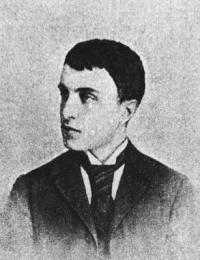Spirituality
Walter Pater: SEBASTIAN VAN STORCK
It was a winter-scene, by Adrian van de Velde, or by Isaac van Ostade. All the delicate poetry together with all the delicate comfort of the frosty season was in the leafless branches turned to silver, the furred dresses of the skaters, the warmth of the red-brick house-fronts under the gauze of white fog, the gleams of pale sunlight on the cuirasses of the mounted soldiers as they receded into the distance. Sebastian van Storck, confessedly the most graceful performer in all that skating multitude, moving in endless maze over the vast surface of the frozen water-meadow, liked best this season of the year for its expression of a perfect impassivity, or at least of a perfect repose.
Walter Pater: DENIS L'AUXERROIS (in inglese)
Almost every people, as we know, has had its legend of a “golden age” and of its return – legends which will hardly be forgotten, however prosaic the world may become, while man himself remains the aspiring, never quite contented being he is. And yet in truth, since we are no longer children, we might well question the advantage of the return to us of a condition of life in which, by the nature of the case, the value of things would, so to speak, lie wholly on their surfaces, unless we could regain also the childish consciousness, or rather unconsciousness, in ourselves, to take all that adroitly and with the appropriate lightness of heart. The dream, however, has been left for the most part in the usual vagueness of dreams: in their waking hours people have been too busy to furnish it forth with details.
Walter Pater: LUCA DELLA ROBBIA (London 1893)
The Italian sculptors of the earlier half of the fifteenth century are more than mere forerunners of the great masters of its close, and often reach perfection, within the narrow limits which they chose to impose on their work. Their sculpture shares with the paintings of Botticelli and the churches of Brunelleschi that profound expressiveness, that intimate impress on an indwelling soul, which is the peculiar fascination of the art of Italy in that century. Their works have been much neglected, and often almost hidden away amid the frippery of modern decoration, and we come with some surprise on the places where their fire still smoulders. One longs to penetrate into the lives of the men who have given expression to so much power and sweetness.
Walter Pater: SANDRO BOTTICELLI (London 1870)
In Leonardo’s treatise on painting only one contemporary is mentioned by name – Sandro Botticelli. The pre-eminence may be due to chance only, but to some will rather appear a result of deliberate judgment; for people have begun to find out the charm of Botticelli’s work, and his name, little known in the last century, is quietly becoming important. In the middle of the fifteenth century he had already anticipated much of that meditative subtlety, which is sometimes supposed peculiar to the great imaginative workmen of its close. Leaving the simple religion which had occupied the followers of Giotto for a century, and the simple naturalism which had grown out of it, a thing of birds and flowers, he sought inspiration in what to him were works of the modern world, the writings of Dante and Boccaccio, and in new readings of his own of classical stories: or, if he painted religious incidents, painted them with an under-current of original sentiment, which touches you as the real matter of the picture through the veil of its ostensible subject.
Walter Pater: PICO DELLA MIRANDOLA
No account of the Renaissance can be complete without some notice of the attempt made by certain Italian scholars of the fifteenth century to reconcile Christianity with the religion of ancient Greece. To reconcile forms of sentiment which at first sight seem incompatible, to adjust the various products of the human mind to one another in one many-sided type of intellectual culture, to give humanity, for heart and imagination to feed upon, as much as it could possibly receive, belonged to the generous instincts of that age.
Monaco Mosè del Monte Athos: SOLITUDINE E SOLITUDINE
Nei nostri giorni accade il seguente ossimoro: mentre gli uomini si accalcano ovunque al punto di darsi gomitate, si sentono sempre più soli. Questo avviene perché hanno una grave difficoltà di comunicazione. Trovano difficoltà nello scambiarsi le idee, nel comprendersi, essere tolleranti nei rapporti col prossimo. I cosiddetti mezzi di comunicazione di massa sono una cosa davvero meschina. Producono propaganda, alienazione, estraniamento e un certo tipo di isolamento. Nessuna pubblicazione e nessuna immagine può sostituire la presenza umana. Di solito a solitudine crea insicurezza, inquietudine, paura, confusione interiore e può condurre fino alla melanconia.
Excerpt from C. Wordsworth: ATTICA [IMPORTANCE OF THE GREEK LANGUAGE FOR THE DISSEMINATION OF CHRISTIANITY]
Ælian recounts that one day Socrates took Alcibiades to a building in the city of Athens, in which maps of different countries were collected. Among them was a chart of the habitable world, as it was then known to the geographers of Greece. The philosopher directed the attention of his young friend to this chart with the intention of reducing the pride in which the latter appeared to indulge due to his vast territorial possessions on the Athenian territory. He asked him to indicate the position of Attica on the map and Alcibiades did so. Now show me where your own estate is located on the map, said Socrates. “It is not possible” answered the other; “you cannot expect my domains to appear there, where even Attica itself occupies so small an area.”







